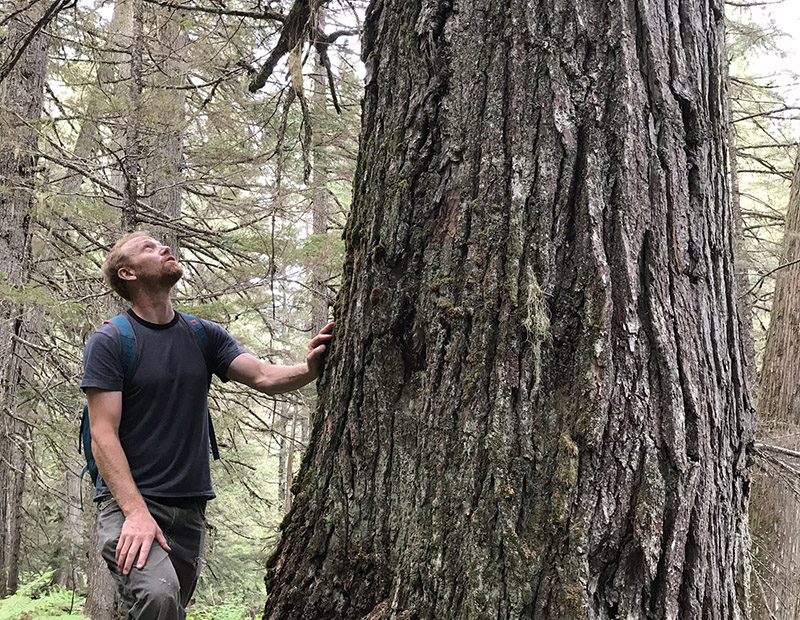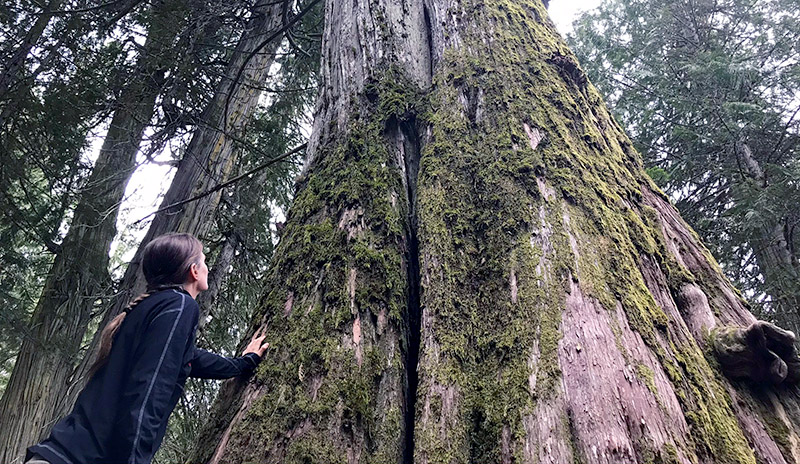Deep. Dark. Quiet. Rare.
Imagine being immersed inside an ancient forest. Soaring trunks and tree canopies rise above you, your feet sink into deep moss and rich earth below. It’s dark and green, the air feels soft and damp, and the scent is fresh and crisp. Welcome to the inland temperate rainforest.
While British Columbia is well known for the temperate rainforest that runs up the coast, it is also home to a lesser known but equally impressive forest type. The inland temperate rainforest is the only one of its kind in the world and covers a large portion of the Yellowstone-to-Yukon region, running from Prince George in northern B.C. south through the Kootenay and Columbia mountains, even into Montana and Idaho.
The inland temperate rainforest is a special place that is serene, yet dynamic, a place of resilience that has lasted for millennia.
Rare habitat for a diverse array of life
This globally unique habitat harbours old-growth trees including ancient cedars that rival the coastal giants. It is home to endangered mountain caribou, flying squirrels and grizzly bears plus a vast array of bird and plant life.
It has taken centuries for some of the largest trees to grow and become the rich, dynamic old-growth forests we know today. Due to climate change it is unlikely trees will ever grow again to that age or size, so the forests of the future will be made up of very different conditions and species. In an interview with The Narwhal, Jim Pojar, a former provincial ecologist says, “I consider these really big, productive old-growth forests to be an irreplaceable, essentially non-renewable resource.”
In other words, we can only keep what we have intact, today.
Inland temperate rainforest is important for people and wildlife
The inland temperate rainforest is diverse, with places for young and old trees, and live and dead trees and plants.
New saplings pop up below towering trees with lichen clinging to their ancient trunks. The soaring canopy provides shady, cooler and wetter areas below and shelters life of all kinds. The forest floor filters water and soaks up rain and snow to prevent flooding.
Incredibly, research from UBC’s Suzanne Simard found these forests contains networks of roots and mycorrhizal fungi that actually help the trees communicate with each other.
Inland rainforests also meet various values and needs for people living in communities nearby, including Indigenous Peoples.
These “ecosystem services” are those provided for free to people by functioning old-growth forests and include food, water, fuel, medicines and timber, recreation and tourism opportunities, and cultural and spiritual values.
Inland temperate rainforests are also important when it comes to sequestering and storing carbon in the forest floor and inside ancient trees. The larger the tree, the more carbon it holds, and even ancient trees continue to sequester carbon as long as they live.
The trees also support biodiversity and make inland temperate rainforest resilient to fires, especially important as climate change impacts our lives.
B.C.’s productive old forest is extremely rare: report
A recent report from independent biologists shows the province of B.C. is using a misleading approach to inventorying old-growth, vastly overestimating how much remains. The government does not differentiate between types of old trees or ecosystems. Anything over 140 years is considered old, but some trees are many hundreds of years old: truly ancient.
Turns out not all old trees provide the same ecological benefits. Many of the forests the province counts as old growth are small trees growing on less productive sites. The giant, truly ancient, trees we think of as old-growth only thrive on productive sites, which are exceedingly rare.
The report shows the reality: less than one percent of the province’s total forest area of more than 57 million hectares is truly highly productive old-growth forest. These are the forests where trees are expected to grow over 25 metres tall in 50 years, or what most people think of when they think of old-growth forests.
According to the report, more than 80 percent of the province’s “old-growth” forests are actually made up of younger, smaller trees. Worse, most of the forest full of the biggest trees and of B.C.’s productive old-growth has already been logged.
The B.C. government claims there is 13.2 million hectares of old-growth in the province. The independent report estimates the number is closer to just 35,000 hectares of the biggest, oldest trees. That’s just slightly smaller than the city of Abbotsford.

Logging is the major threat facing old-growth forests today.
According to the study authors, this government policy means forestry companies can specifically target and harvest big trees, leaving only small, unproductive trees, and still meet their old-growth retention targets.
Old-growth forests are all ecologically valuable but vary in productivity and biodiversity, with the rarest being the most productive forests made up of the biggest, and oldest, trees. To get to the highly productive old-growth forests we need in the future, we need to protect this rare habitat and also the forests that will become old-growth in the future.
Stop the loss now
Speak up for these fantastic forests.
Old-growth forests are one of the natural features that make B.C. special.
Current forestry rules and regulations under B.C.’s Forest and Range Practices Act are not working to protect the sustainability of structural and ecologically complex forests.
Add your name to our petition asking B.C. for strong action to protect our old-growth, including in the Inland Temperate Rainforest.
Further reading and information
- British Columbia’s old growth trees still on the chopping block
- B.C.’s Old-growth Forest: A Last Stand for Biodiversity
- Coxson, D., Goward, T., & Werner, J. R. (2019). The Inland Temperate Rainforest and Interior Wetbelt Biomes of Western North America. In Reference Module in Earth Systems and Environmental Sciences. Elsevier. https://doi.org/10.1016/B978-0-12-409548-9.12055-X
- How much old-growth is in B.C.?
- British Columbia poised to lose ‘white rhino of old-growth forests’


